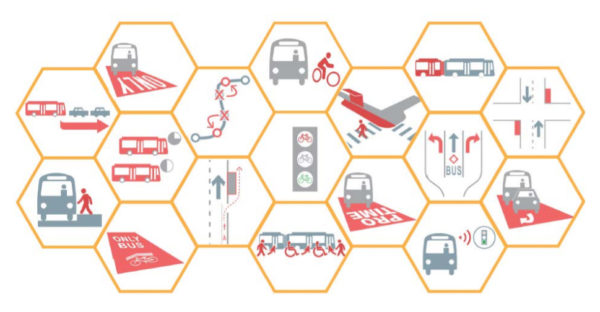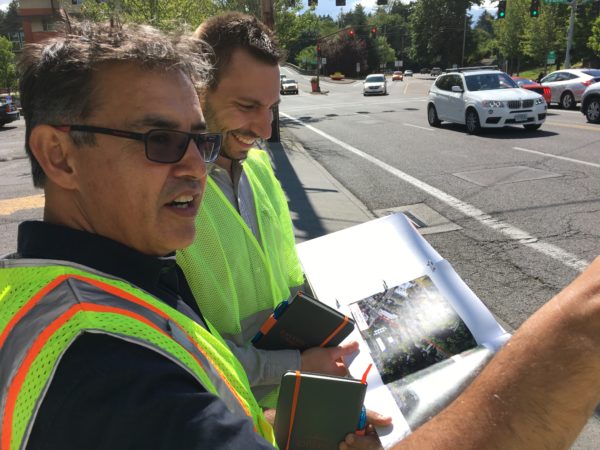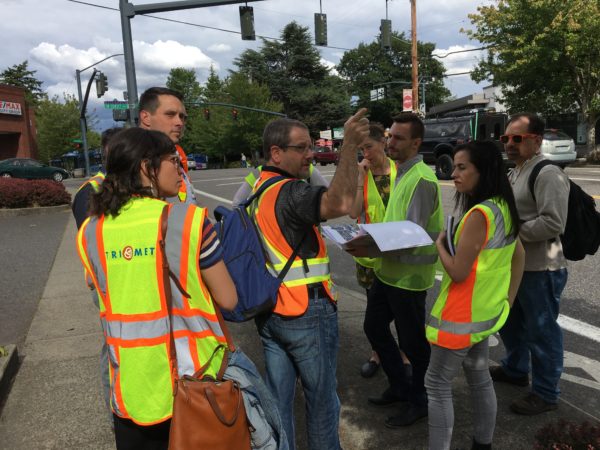Enhanced Transit Corridors: Conceptual Design
TriMet and Portland Bureau of Transportation (PBOT) have developed the Enhanced Transit Corridors (ETC) Plan which aims to make travel by buses faster and more reliable with moderate capital and operational investments. By making trips more convenient and useful, transit will become a more attractive and logical choice for our growing region.

PBOT and TriMet have identified several sites around the Portland-metro for improvement. Emerio is a subconsultant to Jacobs participating in the conceptual planning of the sites, identifying key areas where improvements can be made. Improvements to consider include:
• Dedicated bus lanes
• BAT lanes (business access and transit)
• Pro-Time (peak period only) transit lanes
• Intersection queue jumps
• and much more!
Leading Emerio’s consultant team are Rafael Gaeta, PE, and Ben Ullmann, PE. Currently focusing on the Burnside, Capitol Hwy, and Hillsboro corridors, Rafael and Ben shared their thoughts on this exciting project.

Q: What are your roles on this conceptual phase of the project? If the concepts are selected for implementation, how will you continue to support the project?
RG: I manage the project from Emerio’s side and work with our designers to come up with concepts and see they get completed for on-time delivery to the client.
BU: My role through the conceptual phase is to place the different concepts discussed by the entire team onto paper to see if they are feasible. Once the final concept is selected, we will assist the project by enhancing the concept into full civil plans to be constructed.
Q: What’s unique about this project compared to other conceptual design projects that you’ve worked on before? What are you enjoying about working on the ETC?
BU: I enjoy starting a project at this phase because we get to think outside of the box. Right now, any idea can be a possibility for the final concept.
RG: I am enjoying coming up with unique solutions from the beginning instead of trying to refine existing solutions. I really enjoy the creative process!
Q: What is involved in enhancing a corridor?
BU: There are many ways to enhance a corridor. We can dedicate lanes for transit use only, change signal timing, update lane striping to create better movement of vehicles, or change/consolidate bus stop location that are not heavily used.
Q: How do you balance the often-competing priorities of transit, pedestrians, bikes, and cars into one design?
BU: We have a large team that focus on each discipline. We collaborate and discuss the many concepts to make sure we are providing a final design that helps all modes of transportation.
RG: We look at trying to provide the greatest benefit to the community. It is all about balance.
Q: You both are cyclists. Does this experience help inform your concepts?
RG: Yes. I am a driver and a cyclist and my experiences with both have made me much more aware of how important good infrastructure is for everyone.
BU: Absolutely. When we create designs, I am always thinking about how we can help bicyclists feel safer on busy streets.

Q: You recently visited the Capitol Hwy site (between SW Bertha Blvd and SW Sunset Blvd) with members of the ETC team to observe traffic and issues associated with this particular site. Can you discuss the what makes this area a good candidate for enhancement?
RG: The intersection at SW Bertha is confusing and can get backed up during peak travel times. This causes speed issues for buses and safety issues for everyone which we are working to solve. We also observed issues with inadequate bike facilities through the intersection and hope to fix that as well.
Q: Emerio is also on the team for the Burnside and Hillsboro corridors. Anything interesting about those sites?
BU: What I find interesting about the Burnside corridor is how many people we can provide a better transit experience for. The corridor starts at the Beaverton Transit Center and runs all the way to Gresham Transit Center, so the impact for riders could be incredible.
RG: Hillsboro Transit Center adds another level of complexity as it is a MAX stop so we need to make sure bikes and pedestrians are moving safely through the area.
Q: What’s next for these projects?
RG: Once a concept is selected for each corridor we can move on to preliminary engineering. We are excited to see these concepts come to life!

